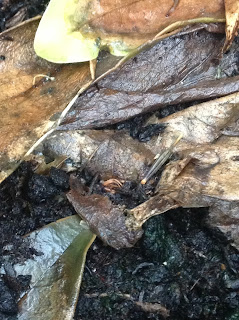I didn’t think my original final piece was consistent with
my previous coursework so in order for my art work to flow and remain relevant
to my theme I reworked the original (below).
I began by cutting
the board up into three sections and keeping the original painted sunset as it related
to my prep work and use of warm colours. However the original cacti lacked the
detail and collage aspects of my previous work. So for each board I explored separate
aspects from my previous work to then form a triptych of collage, sketches and
transfer techniques (all shown on previous sheets of work).
For the first board I used layered torn sheets as I had on
my collage sheet of work, and on how I had painted over print in the past. I
tea stained pages from a book my family have had for 5 generations, in order to
link to my theme of traces, the tea stain aged them even more and picked up all
the small crinkles and tears in the paper.
I then sketched cacti over the top from various angles and
in different tones, I chose them to represent the Mexican/American side of my
family and the merge of my English family (by using the old book).
In order to make the original
background blend successfully I dry brushed paint into the paper so the
composition of the piece didn’t go through two harsh extremes. It also gave the
paper an effect similar to a faded photo, similar to Rauschenberg’s Retroactive
(1963) (canvas and collage) [http://www.thewadsworth.org/robert-rauschenberg-retroactive-i/]
due to the way the contrasting colours blend subtlety.
For my second board I
kept the composition of the sunset at the top in order to keep a consistency with
the other pieces, although I painted it upside-down so the paint drips and
cacti are drawn upside down to keep a contrast with the other paintings this is
why this is placed in the centre of the triptych to show its obvious
difference.
This painting base of rough white emulsion was created by
accident whilst trying to cover the original image but the texture created an
ideal surface for charcoal rubbing and paint dripping. The detail sketches and
base of vibrant colour are inspired by Kahlo and her use of intricate yet
heavily charcoal shaded sketches combined with her use of warm Mexican folk art
tonal colour.
The black paint drips are based on a piece I created
previously which was based on Jose Parlas’s Love affair with drips over a
detailed background which I added to this piece to combine some of my transfer
technique work in.
For my third board I focused on
the texture and roots of the cacti using tonal pencils similar to my original observational
sketches. I chose to only do sketching instead of collage on this board to
highlight the tones and shadows of the sunset; however I didn’t use shadow on
the cacti to make it seem more similar to Kahlo and Rivera’s use of surrealism
and folk art where shadows often aren’t features unlike in realism.
Overall I prefer my redone boards
due to how they bring the coursework together into a more consistent project by
featuring many sections and artists from previous works as well as drawing from
my colour and tonal prep work in my sketchbook.













































